Influence of OB, Culture, and Motivation on Versace's Performance
VerifiedAdded on 2023/01/13
|16
|5454
|54
Report
AI Summary
This report provides an in-depth analysis of organizational behaviour within the Versace company. It explores the influence of power, organizational culture, and politics on team behaviour and performance, referencing models such as the French and Raven Model of Power and Handy's Culture Model. The report delves into various theories of motivation, including Maslow's Hierarchy of Needs and the Two-Factor Theory, and examines how these theories can be applied to enhance employee achievement. Furthermore, the analysis considers team development theory, differentiating between effective and ineffective team dynamics within Versace. The report also discusses key concepts of organizational behaviour and their practical applications, providing a comprehensive understanding of how these elements shape the company's operational efficiency and employee engagement.
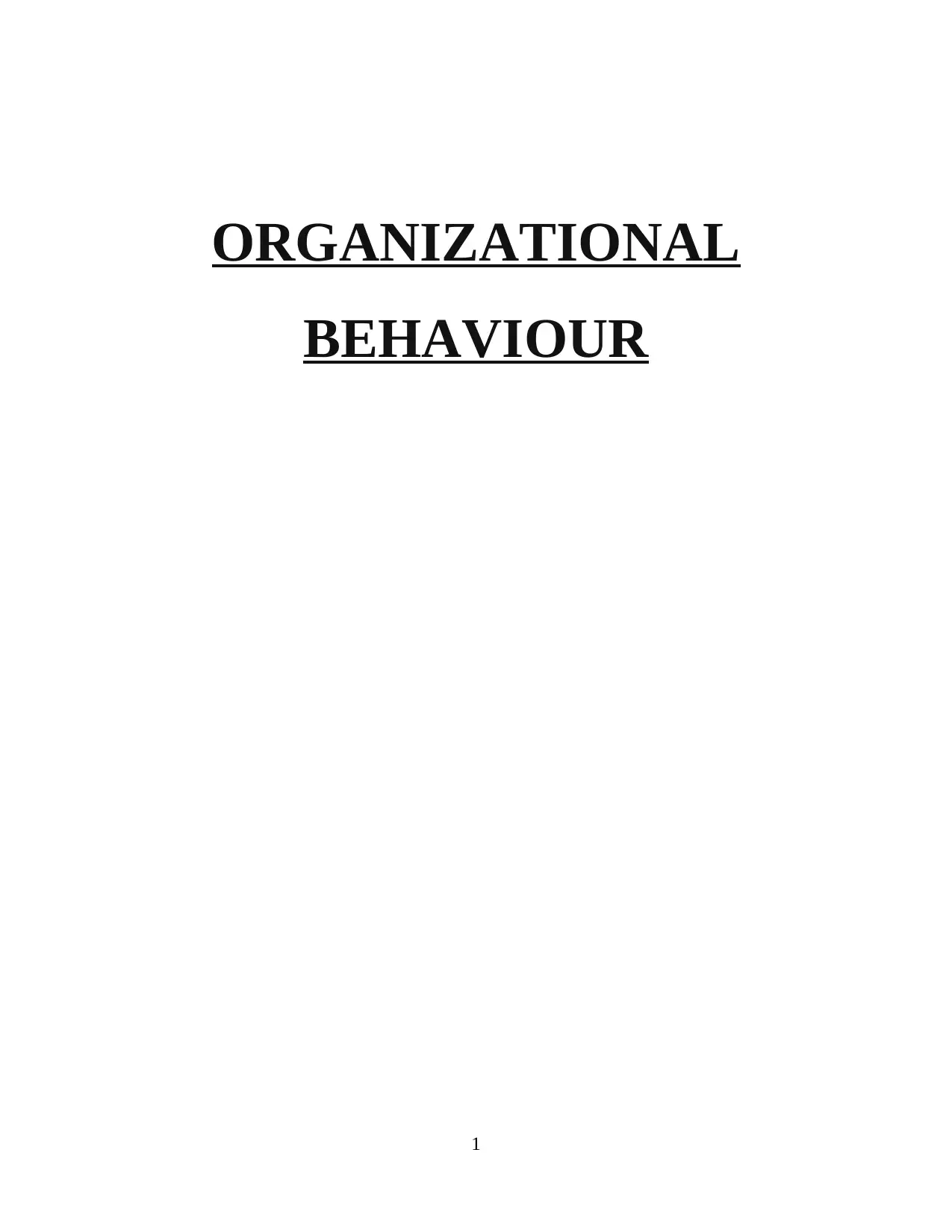
ORGANIZATIONAL
BEHAVIOUR
1
BEHAVIOUR
1
Paraphrase This Document
Need a fresh take? Get an instant paraphrase of this document with our AI Paraphraser
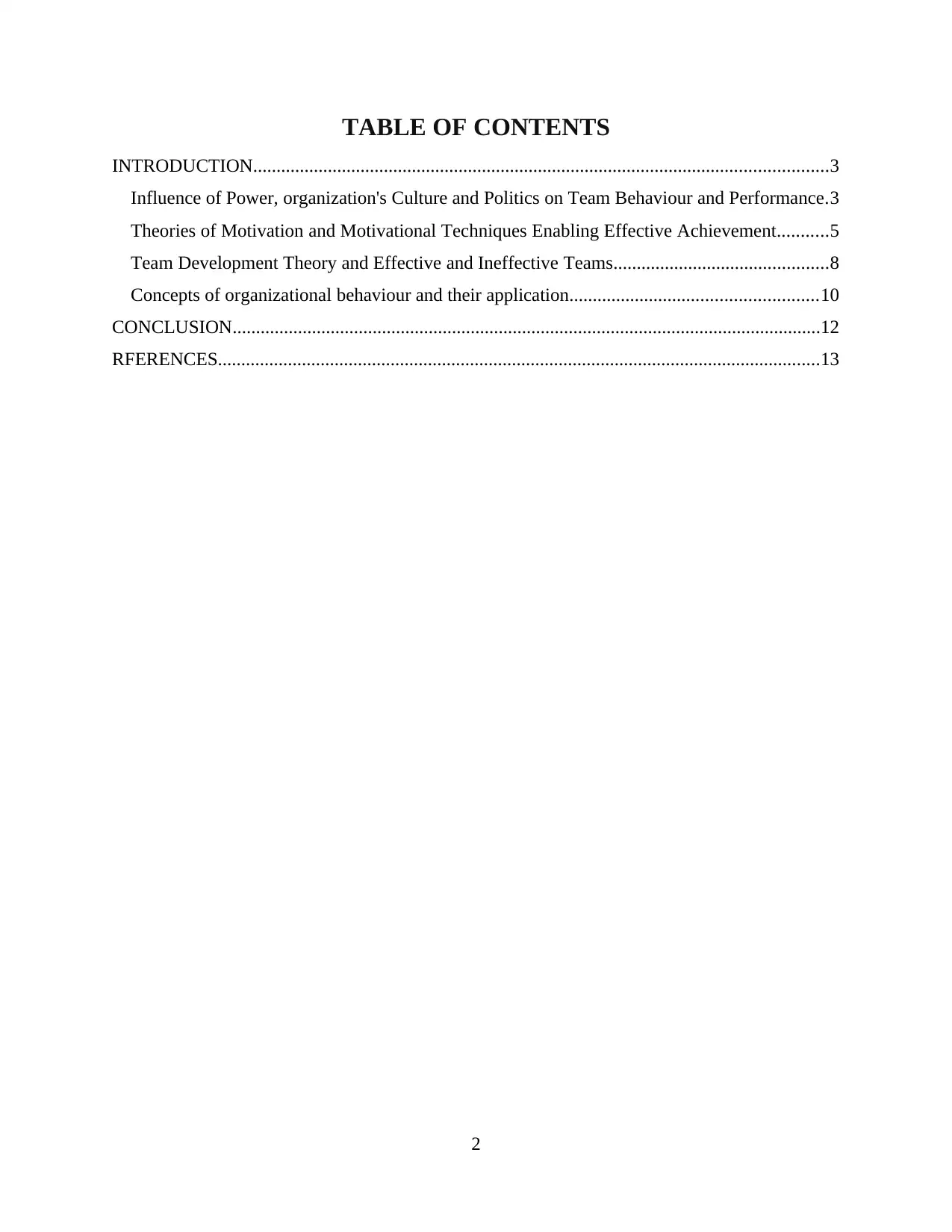
TABLE OF CONTENTS
INTRODUCTION...........................................................................................................................3
Influence of Power, organization's Culture and Politics on Team Behaviour and Performance.3
Theories of Motivation and Motivational Techniques Enabling Effective Achievement...........5
Team Development Theory and Effective and Ineffective Teams..............................................8
Concepts of organizational behaviour and their application.....................................................10
CONCLUSION..............................................................................................................................12
RFERENCES.................................................................................................................................13
2
INTRODUCTION...........................................................................................................................3
Influence of Power, organization's Culture and Politics on Team Behaviour and Performance.3
Theories of Motivation and Motivational Techniques Enabling Effective Achievement...........5
Team Development Theory and Effective and Ineffective Teams..............................................8
Concepts of organizational behaviour and their application.....................................................10
CONCLUSION..............................................................................................................................12
RFERENCES.................................................................................................................................13
2
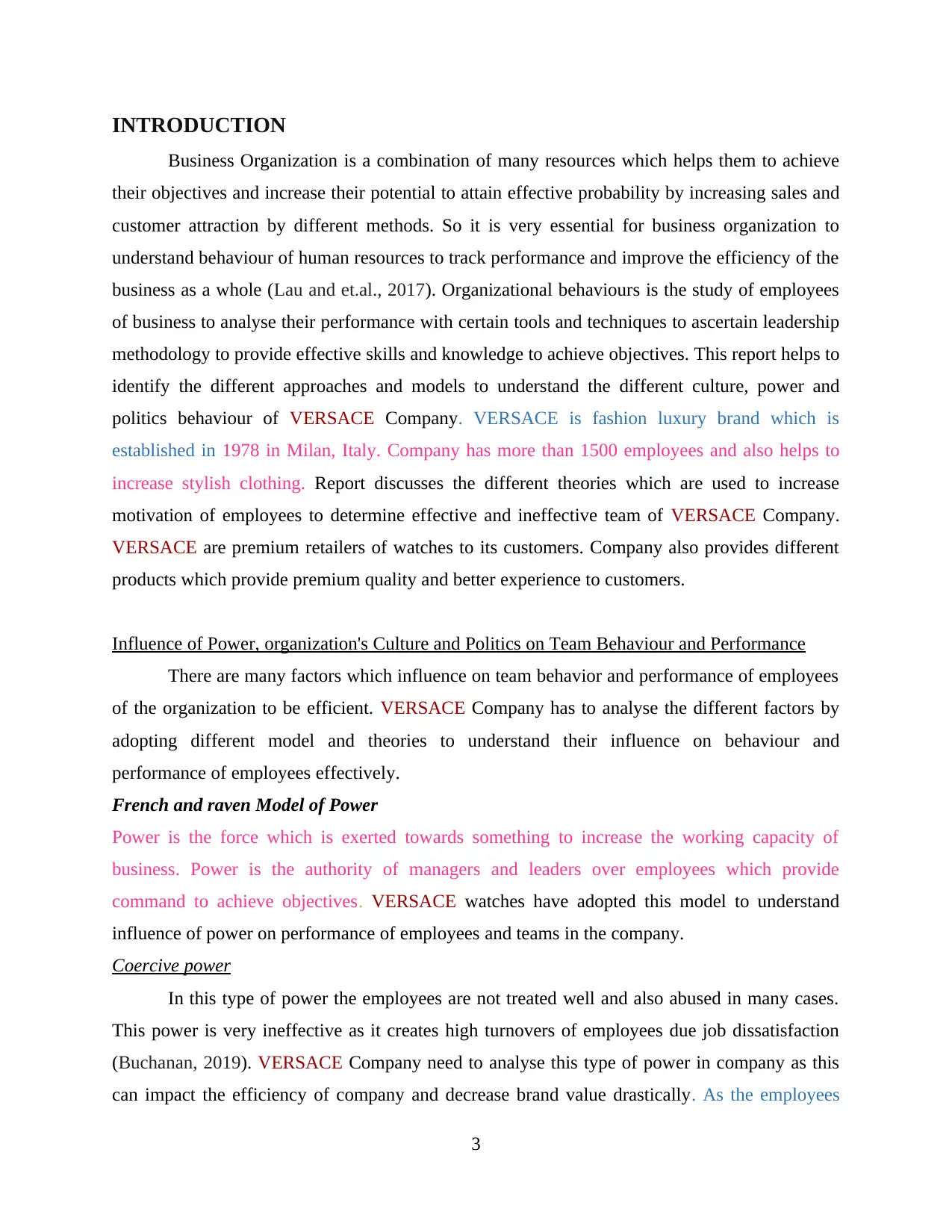
INTRODUCTION
Business Organization is a combination of many resources which helps them to achieve
their objectives and increase their potential to attain effective probability by increasing sales and
customer attraction by different methods. So it is very essential for business organization to
understand behaviour of human resources to track performance and improve the efficiency of the
business as a whole (Lau and et.al., 2017). Organizational behaviours is the study of employees
of business to analyse their performance with certain tools and techniques to ascertain leadership
methodology to provide effective skills and knowledge to achieve objectives. This report helps to
identify the different approaches and models to understand the different culture, power and
politics behaviour of VERSACE Company. VERSACE is fashion luxury brand which is
established in 1978 in Milan, Italy. Company has more than 1500 employees and also helps to
increase stylish clothing. Report discusses the different theories which are used to increase
motivation of employees to determine effective and ineffective team of VERSACE Company.
VERSACE are premium retailers of watches to its customers. Company also provides different
products which provide premium quality and better experience to customers.
Influence of Power, organization's Culture and Politics on Team Behaviour and Performance
There are many factors which influence on team behavior and performance of employees
of the organization to be efficient. VERSACE Company has to analyse the different factors by
adopting different model and theories to understand their influence on behaviour and
performance of employees effectively.
French and raven Model of Power
Power is the force which is exerted towards something to increase the working capacity of
business. Power is the authority of managers and leaders over employees which provide
command to achieve objectives. VERSACE watches have adopted this model to understand
influence of power on performance of employees and teams in the company.
Coercive power
In this type of power the employees are not treated well and also abused in many cases.
This power is very ineffective as it creates high turnovers of employees due job dissatisfaction
(Buchanan, 2019). VERSACE Company need to analyse this type of power in company as this
can impact the efficiency of company and decrease brand value drastically. As the employees
3
Business Organization is a combination of many resources which helps them to achieve
their objectives and increase their potential to attain effective probability by increasing sales and
customer attraction by different methods. So it is very essential for business organization to
understand behaviour of human resources to track performance and improve the efficiency of the
business as a whole (Lau and et.al., 2017). Organizational behaviours is the study of employees
of business to analyse their performance with certain tools and techniques to ascertain leadership
methodology to provide effective skills and knowledge to achieve objectives. This report helps to
identify the different approaches and models to understand the different culture, power and
politics behaviour of VERSACE Company. VERSACE is fashion luxury brand which is
established in 1978 in Milan, Italy. Company has more than 1500 employees and also helps to
increase stylish clothing. Report discusses the different theories which are used to increase
motivation of employees to determine effective and ineffective team of VERSACE Company.
VERSACE are premium retailers of watches to its customers. Company also provides different
products which provide premium quality and better experience to customers.
Influence of Power, organization's Culture and Politics on Team Behaviour and Performance
There are many factors which influence on team behavior and performance of employees
of the organization to be efficient. VERSACE Company has to analyse the different factors by
adopting different model and theories to understand their influence on behaviour and
performance of employees effectively.
French and raven Model of Power
Power is the force which is exerted towards something to increase the working capacity of
business. Power is the authority of managers and leaders over employees which provide
command to achieve objectives. VERSACE watches have adopted this model to understand
influence of power on performance of employees and teams in the company.
Coercive power
In this type of power the employees are not treated well and also abused in many cases.
This power is very ineffective as it creates high turnovers of employees due job dissatisfaction
(Buchanan, 2019). VERSACE Company need to analyse this type of power in company as this
can impact the efficiency of company and decrease brand value drastically. As the employees
3
You're viewing a preview
Unlock full access by subscribing today!
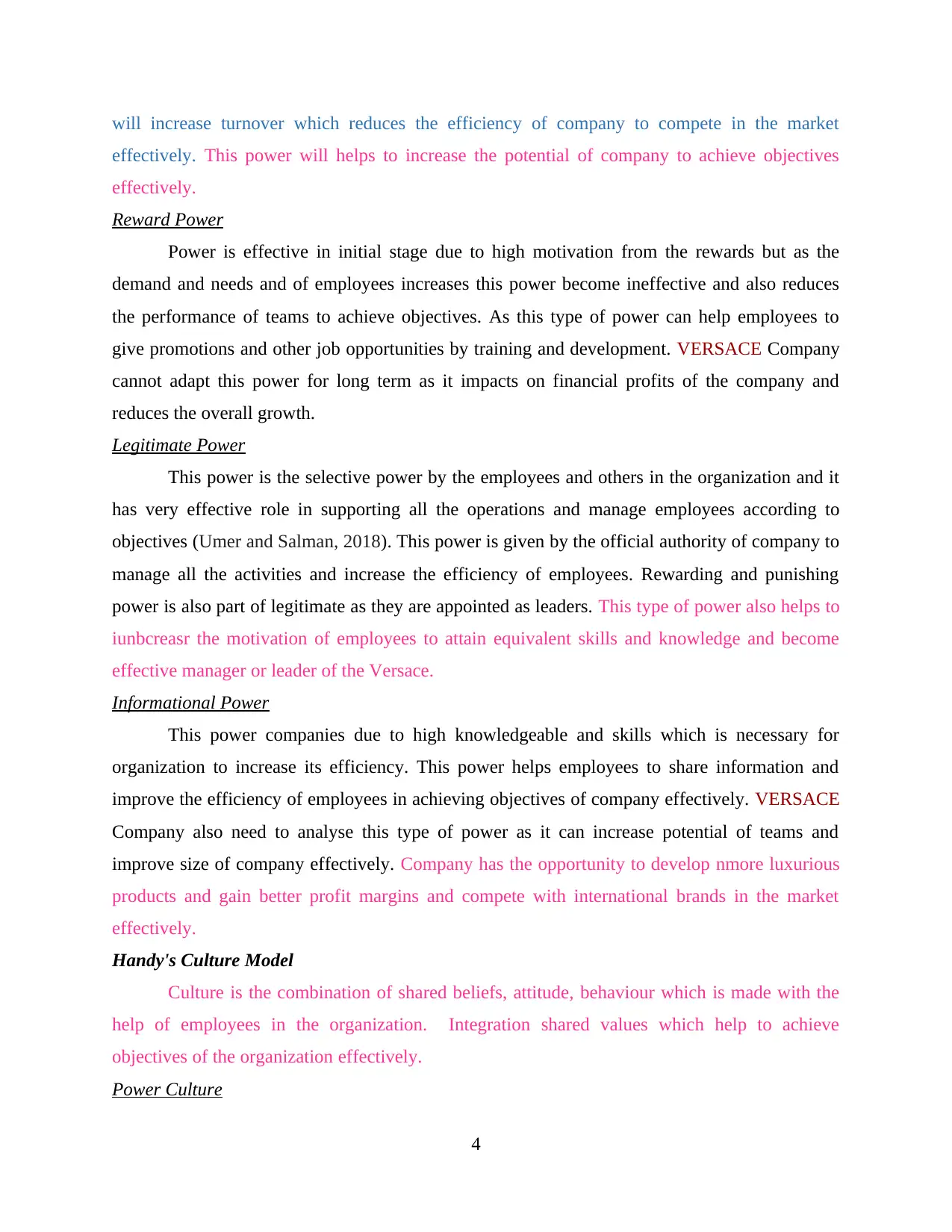
will increase turnover which reduces the efficiency of company to compete in the market
effectively. This power will helps to increase the potential of company to achieve objectives
effectively.
Reward Power
Power is effective in initial stage due to high motivation from the rewards but as the
demand and needs and of employees increases this power become ineffective and also reduces
the performance of teams to achieve objectives. As this type of power can help employees to
give promotions and other job opportunities by training and development. VERSACE Company
cannot adapt this power for long term as it impacts on financial profits of the company and
reduces the overall growth.
Legitimate Power
This power is the selective power by the employees and others in the organization and it
has very effective role in supporting all the operations and manage employees according to
objectives (Umer and Salman, 2018). This power is given by the official authority of company to
manage all the activities and increase the efficiency of employees. Rewarding and punishing
power is also part of legitimate as they are appointed as leaders. This type of power also helps to
iunbcreasr the motivation of employees to attain equivalent skills and knowledge and become
effective manager or leader of the Versace.
Informational Power
This power companies due to high knowledgeable and skills which is necessary for
organization to increase its efficiency. This power helps employees to share information and
improve the efficiency of employees in achieving objectives of company effectively. VERSACE
Company also need to analyse this type of power as it can increase potential of teams and
improve size of company effectively. Company has the opportunity to develop nmore luxurious
products and gain better profit margins and compete with international brands in the market
effectively.
Handy's Culture Model
Culture is the combination of shared beliefs, attitude, behaviour which is made with the
help of employees in the organization. Integration shared values which help to achieve
objectives of the organization effectively.
Power Culture
4
effectively. This power will helps to increase the potential of company to achieve objectives
effectively.
Reward Power
Power is effective in initial stage due to high motivation from the rewards but as the
demand and needs and of employees increases this power become ineffective and also reduces
the performance of teams to achieve objectives. As this type of power can help employees to
give promotions and other job opportunities by training and development. VERSACE Company
cannot adapt this power for long term as it impacts on financial profits of the company and
reduces the overall growth.
Legitimate Power
This power is the selective power by the employees and others in the organization and it
has very effective role in supporting all the operations and manage employees according to
objectives (Umer and Salman, 2018). This power is given by the official authority of company to
manage all the activities and increase the efficiency of employees. Rewarding and punishing
power is also part of legitimate as they are appointed as leaders. This type of power also helps to
iunbcreasr the motivation of employees to attain equivalent skills and knowledge and become
effective manager or leader of the Versace.
Informational Power
This power companies due to high knowledgeable and skills which is necessary for
organization to increase its efficiency. This power helps employees to share information and
improve the efficiency of employees in achieving objectives of company effectively. VERSACE
Company also need to analyse this type of power as it can increase potential of teams and
improve size of company effectively. Company has the opportunity to develop nmore luxurious
products and gain better profit margins and compete with international brands in the market
effectively.
Handy's Culture Model
Culture is the combination of shared beliefs, attitude, behaviour which is made with the
help of employees in the organization. Integration shared values which help to achieve
objectives of the organization effectively.
Power Culture
4
Paraphrase This Document
Need a fresh take? Get an instant paraphrase of this document with our AI Paraphraser
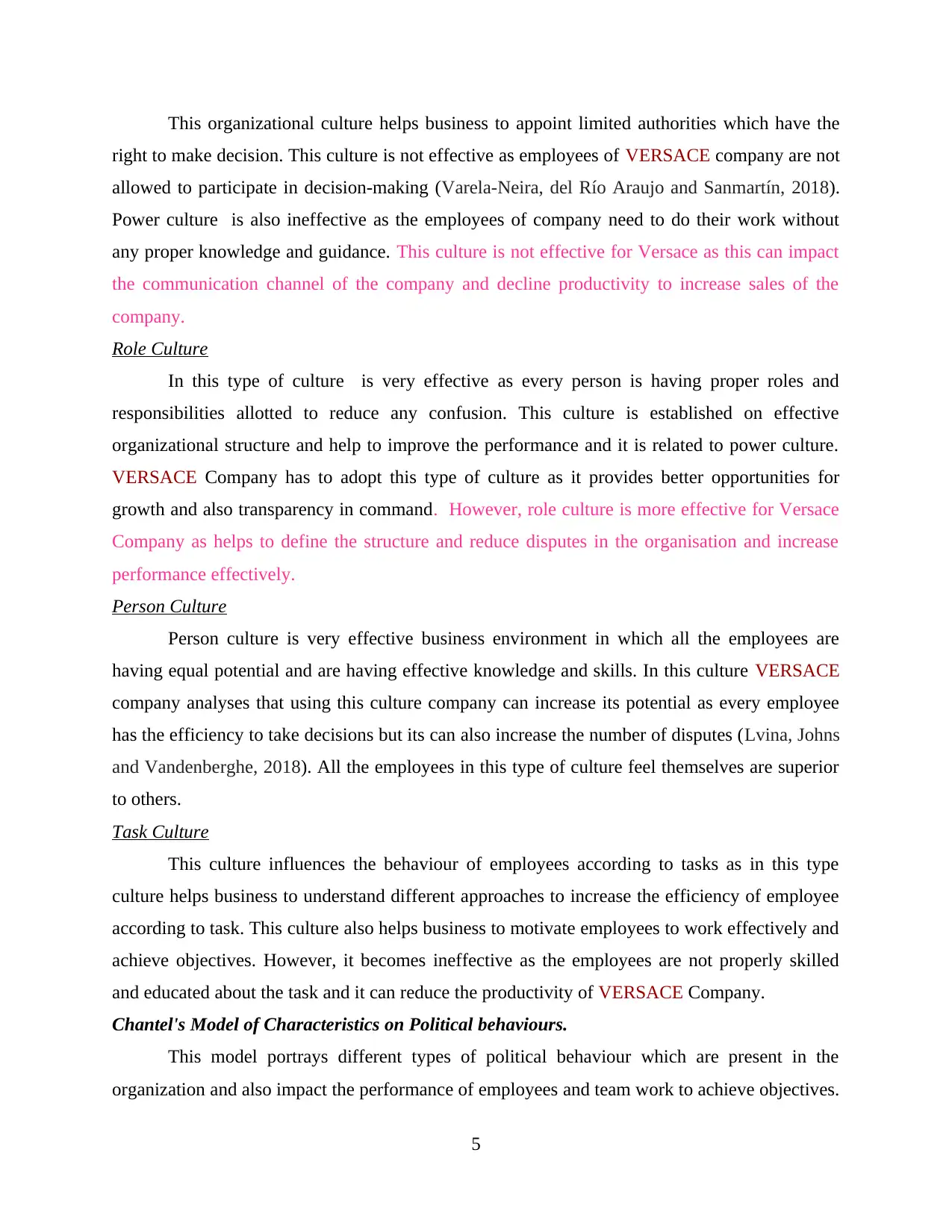
This organizational culture helps business to appoint limited authorities which have the
right to make decision. This culture is not effective as employees of VERSACE company are not
allowed to participate in decision-making (Varela-Neira, del Río Araujo and Sanmartín, 2018).
Power culture is also ineffective as the employees of company need to do their work without
any proper knowledge and guidance. This culture is not effective for Versace as this can impact
the communication channel of the company and decline productivity to increase sales of the
company.
Role Culture
In this type of culture is very effective as every person is having proper roles and
responsibilities allotted to reduce any confusion. This culture is established on effective
organizational structure and help to improve the performance and it is related to power culture.
VERSACE Company has to adopt this type of culture as it provides better opportunities for
growth and also transparency in command. However, role culture is more effective for Versace
Company as helps to define the structure and reduce disputes in the organisation and increase
performance effectively.
Person Culture
Person culture is very effective business environment in which all the employees are
having equal potential and are having effective knowledge and skills. In this culture VERSACE
company analyses that using this culture company can increase its potential as every employee
has the efficiency to take decisions but its can also increase the number of disputes (Lvina, Johns
and Vandenberghe, 2018). All the employees in this type of culture feel themselves are superior
to others.
Task Culture
This culture influences the behaviour of employees according to tasks as in this type
culture helps business to understand different approaches to increase the efficiency of employee
according to task. This culture also helps business to motivate employees to work effectively and
achieve objectives. However, it becomes ineffective as the employees are not properly skilled
and educated about the task and it can reduce the productivity of VERSACE Company.
Chantel's Model of Characteristics on Political behaviours.
This model portrays different types of political behaviour which are present in the
organization and also impact the performance of employees and team work to achieve objectives.
5
right to make decision. This culture is not effective as employees of VERSACE company are not
allowed to participate in decision-making (Varela-Neira, del Río Araujo and Sanmartín, 2018).
Power culture is also ineffective as the employees of company need to do their work without
any proper knowledge and guidance. This culture is not effective for Versace as this can impact
the communication channel of the company and decline productivity to increase sales of the
company.
Role Culture
In this type of culture is very effective as every person is having proper roles and
responsibilities allotted to reduce any confusion. This culture is established on effective
organizational structure and help to improve the performance and it is related to power culture.
VERSACE Company has to adopt this type of culture as it provides better opportunities for
growth and also transparency in command. However, role culture is more effective for Versace
Company as helps to define the structure and reduce disputes in the organisation and increase
performance effectively.
Person Culture
Person culture is very effective business environment in which all the employees are
having equal potential and are having effective knowledge and skills. In this culture VERSACE
company analyses that using this culture company can increase its potential as every employee
has the efficiency to take decisions but its can also increase the number of disputes (Lvina, Johns
and Vandenberghe, 2018). All the employees in this type of culture feel themselves are superior
to others.
Task Culture
This culture influences the behaviour of employees according to tasks as in this type
culture helps business to understand different approaches to increase the efficiency of employee
according to task. This culture also helps business to motivate employees to work effectively and
achieve objectives. However, it becomes ineffective as the employees are not properly skilled
and educated about the task and it can reduce the productivity of VERSACE Company.
Chantel's Model of Characteristics on Political behaviours.
This model portrays different types of political behaviour which are present in the
organization and also impact the performance of employees and team work to achieve objectives.
5
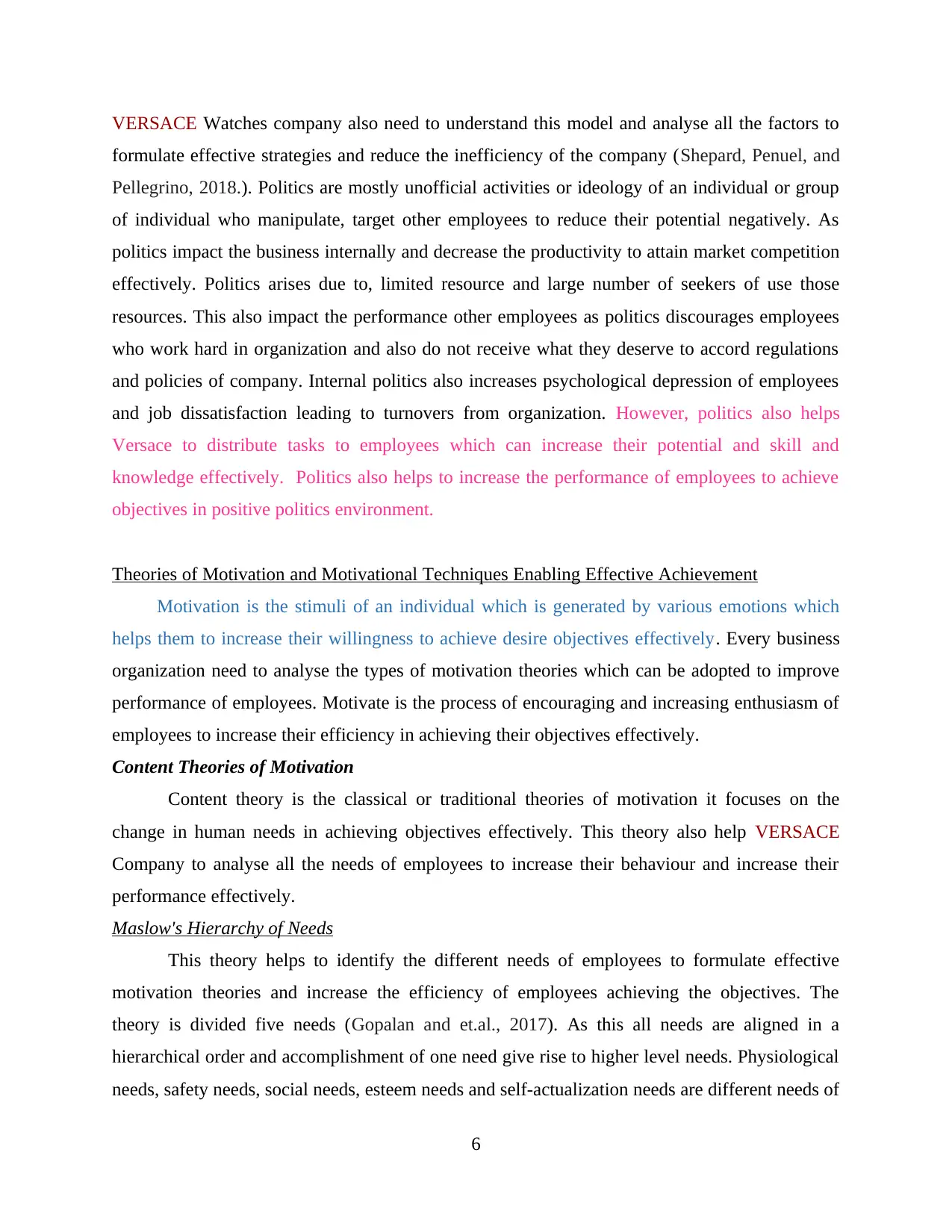
VERSACE Watches company also need to understand this model and analyse all the factors to
formulate effective strategies and reduce the inefficiency of the company (Shepard, Penuel, and
Pellegrino, 2018.). Politics are mostly unofficial activities or ideology of an individual or group
of individual who manipulate, target other employees to reduce their potential negatively. As
politics impact the business internally and decrease the productivity to attain market competition
effectively. Politics arises due to, limited resource and large number of seekers of use those
resources. This also impact the performance other employees as politics discourages employees
who work hard in organization and also do not receive what they deserve to accord regulations
and policies of company. Internal politics also increases psychological depression of employees
and job dissatisfaction leading to turnovers from organization. However, politics also helps
Versace to distribute tasks to employees which can increase their potential and skill and
knowledge effectively. Politics also helps to increase the performance of employees to achieve
objectives in positive politics environment.
Theories of Motivation and Motivational Techniques Enabling Effective Achievement
Motivation is the stimuli of an individual which is generated by various emotions which
helps them to increase their willingness to achieve desire objectives effectively. Every business
organization need to analyse the types of motivation theories which can be adopted to improve
performance of employees. Motivate is the process of encouraging and increasing enthusiasm of
employees to increase their efficiency in achieving their objectives effectively.
Content Theories of Motivation
Content theory is the classical or traditional theories of motivation it focuses on the
change in human needs in achieving objectives effectively. This theory also help VERSACE
Company to analyse all the needs of employees to increase their behaviour and increase their
performance effectively.
Maslow's Hierarchy of Needs
This theory helps to identify the different needs of employees to formulate effective
motivation theories and increase the efficiency of employees achieving the objectives. The
theory is divided five needs (Gopalan and et.al., 2017). As this all needs are aligned in a
hierarchical order and accomplishment of one need give rise to higher level needs. Physiological
needs, safety needs, social needs, esteem needs and self-actualization needs are different needs of
6
formulate effective strategies and reduce the inefficiency of the company (Shepard, Penuel, and
Pellegrino, 2018.). Politics are mostly unofficial activities or ideology of an individual or group
of individual who manipulate, target other employees to reduce their potential negatively. As
politics impact the business internally and decrease the productivity to attain market competition
effectively. Politics arises due to, limited resource and large number of seekers of use those
resources. This also impact the performance other employees as politics discourages employees
who work hard in organization and also do not receive what they deserve to accord regulations
and policies of company. Internal politics also increases psychological depression of employees
and job dissatisfaction leading to turnovers from organization. However, politics also helps
Versace to distribute tasks to employees which can increase their potential and skill and
knowledge effectively. Politics also helps to increase the performance of employees to achieve
objectives in positive politics environment.
Theories of Motivation and Motivational Techniques Enabling Effective Achievement
Motivation is the stimuli of an individual which is generated by various emotions which
helps them to increase their willingness to achieve desire objectives effectively. Every business
organization need to analyse the types of motivation theories which can be adopted to improve
performance of employees. Motivate is the process of encouraging and increasing enthusiasm of
employees to increase their efficiency in achieving their objectives effectively.
Content Theories of Motivation
Content theory is the classical or traditional theories of motivation it focuses on the
change in human needs in achieving objectives effectively. This theory also help VERSACE
Company to analyse all the needs of employees to increase their behaviour and increase their
performance effectively.
Maslow's Hierarchy of Needs
This theory helps to identify the different needs of employees to formulate effective
motivation theories and increase the efficiency of employees achieving the objectives. The
theory is divided five needs (Gopalan and et.al., 2017). As this all needs are aligned in a
hierarchical order and accomplishment of one need give rise to higher level needs. Physiological
needs, safety needs, social needs, esteem needs and self-actualization needs are different needs of
6
You're viewing a preview
Unlock full access by subscribing today!
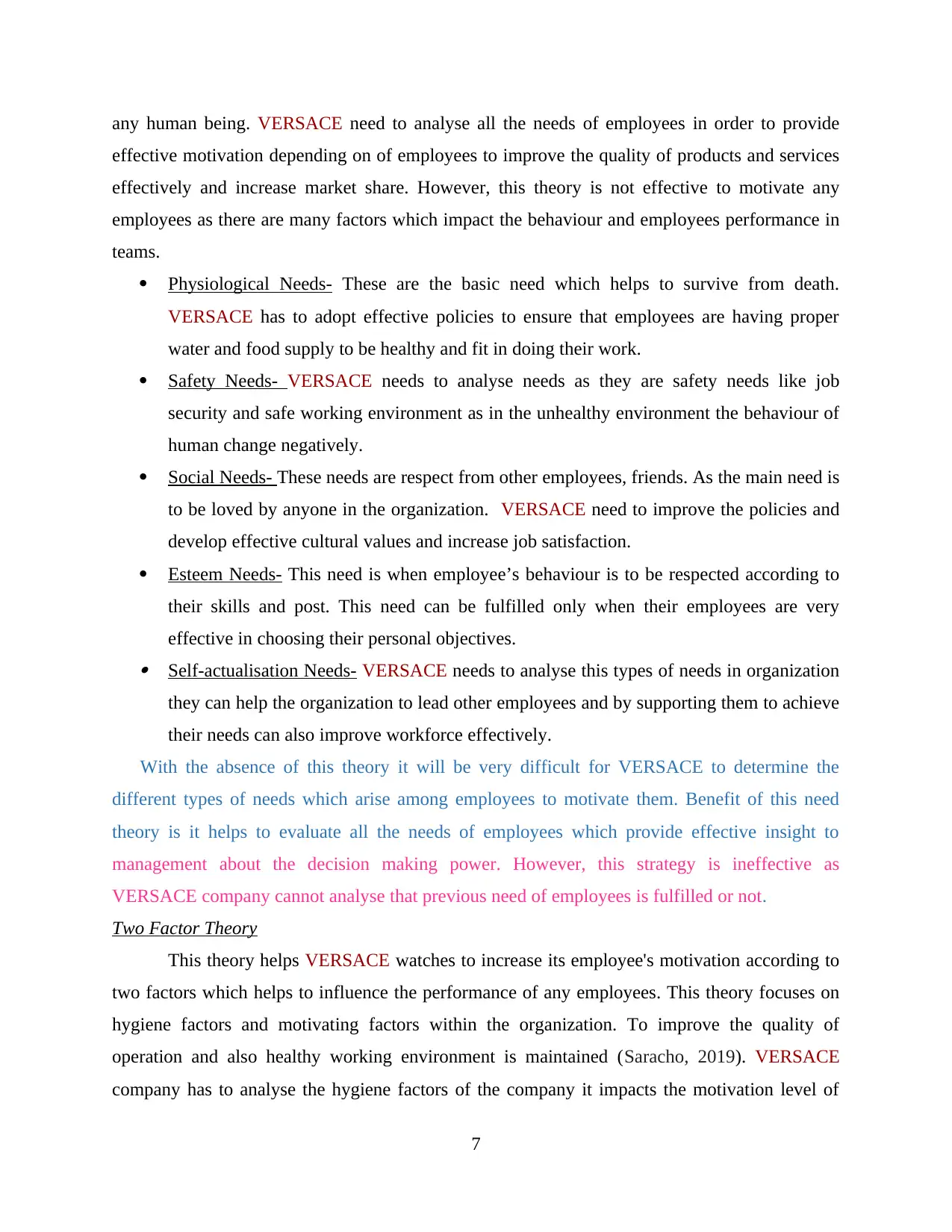
any human being. VERSACE need to analyse all the needs of employees in order to provide
effective motivation depending on of employees to improve the quality of products and services
effectively and increase market share. However, this theory is not effective to motivate any
employees as there are many factors which impact the behaviour and employees performance in
teams.
Physiological Needs- These are the basic need which helps to survive from death.
VERSACE has to adopt effective policies to ensure that employees are having proper
water and food supply to be healthy and fit in doing their work.
Safety Needs- VERSACE needs to analyse needs as they are safety needs like job
security and safe working environment as in the unhealthy environment the behaviour of
human change negatively.
Social Needs- These needs are respect from other employees, friends. As the main need is
to be loved by anyone in the organization. VERSACE need to improve the policies and
develop effective cultural values and increase job satisfaction.
Esteem Needs- This need is when employee’s behaviour is to be respected according to
their skills and post. This need can be fulfilled only when their employees are very
effective in choosing their personal objectives. Self-actualisation Needs- VERSACE needs to analyse this types of needs in organization
they can help the organization to lead other employees and by supporting them to achieve
their needs can also improve workforce effectively.
With the absence of this theory it will be very difficult for VERSACE to determine the
different types of needs which arise among employees to motivate them. Benefit of this need
theory is it helps to evaluate all the needs of employees which provide effective insight to
management about the decision making power. However, this strategy is ineffective as
VERSACE company cannot analyse that previous need of employees is fulfilled or not.
Two Factor Theory
This theory helps VERSACE watches to increase its employee's motivation according to
two factors which helps to influence the performance of any employees. This theory focuses on
hygiene factors and motivating factors within the organization. To improve the quality of
operation and also healthy working environment is maintained (Saracho, 2019). VERSACE
company has to analyse the hygiene factors of the company it impacts the motivation level of
7
effective motivation depending on of employees to improve the quality of products and services
effectively and increase market share. However, this theory is not effective to motivate any
employees as there are many factors which impact the behaviour and employees performance in
teams.
Physiological Needs- These are the basic need which helps to survive from death.
VERSACE has to adopt effective policies to ensure that employees are having proper
water and food supply to be healthy and fit in doing their work.
Safety Needs- VERSACE needs to analyse needs as they are safety needs like job
security and safe working environment as in the unhealthy environment the behaviour of
human change negatively.
Social Needs- These needs are respect from other employees, friends. As the main need is
to be loved by anyone in the organization. VERSACE need to improve the policies and
develop effective cultural values and increase job satisfaction.
Esteem Needs- This need is when employee’s behaviour is to be respected according to
their skills and post. This need can be fulfilled only when their employees are very
effective in choosing their personal objectives. Self-actualisation Needs- VERSACE needs to analyse this types of needs in organization
they can help the organization to lead other employees and by supporting them to achieve
their needs can also improve workforce effectively.
With the absence of this theory it will be very difficult for VERSACE to determine the
different types of needs which arise among employees to motivate them. Benefit of this need
theory is it helps to evaluate all the needs of employees which provide effective insight to
management about the decision making power. However, this strategy is ineffective as
VERSACE company cannot analyse that previous need of employees is fulfilled or not.
Two Factor Theory
This theory helps VERSACE watches to increase its employee's motivation according to
two factors which helps to influence the performance of any employees. This theory focuses on
hygiene factors and motivating factors within the organization. To improve the quality of
operation and also healthy working environment is maintained (Saracho, 2019). VERSACE
company has to analyse the hygiene factors of the company it impacts the motivation level of
7
Paraphrase This Document
Need a fresh take? Get an instant paraphrase of this document with our AI Paraphraser
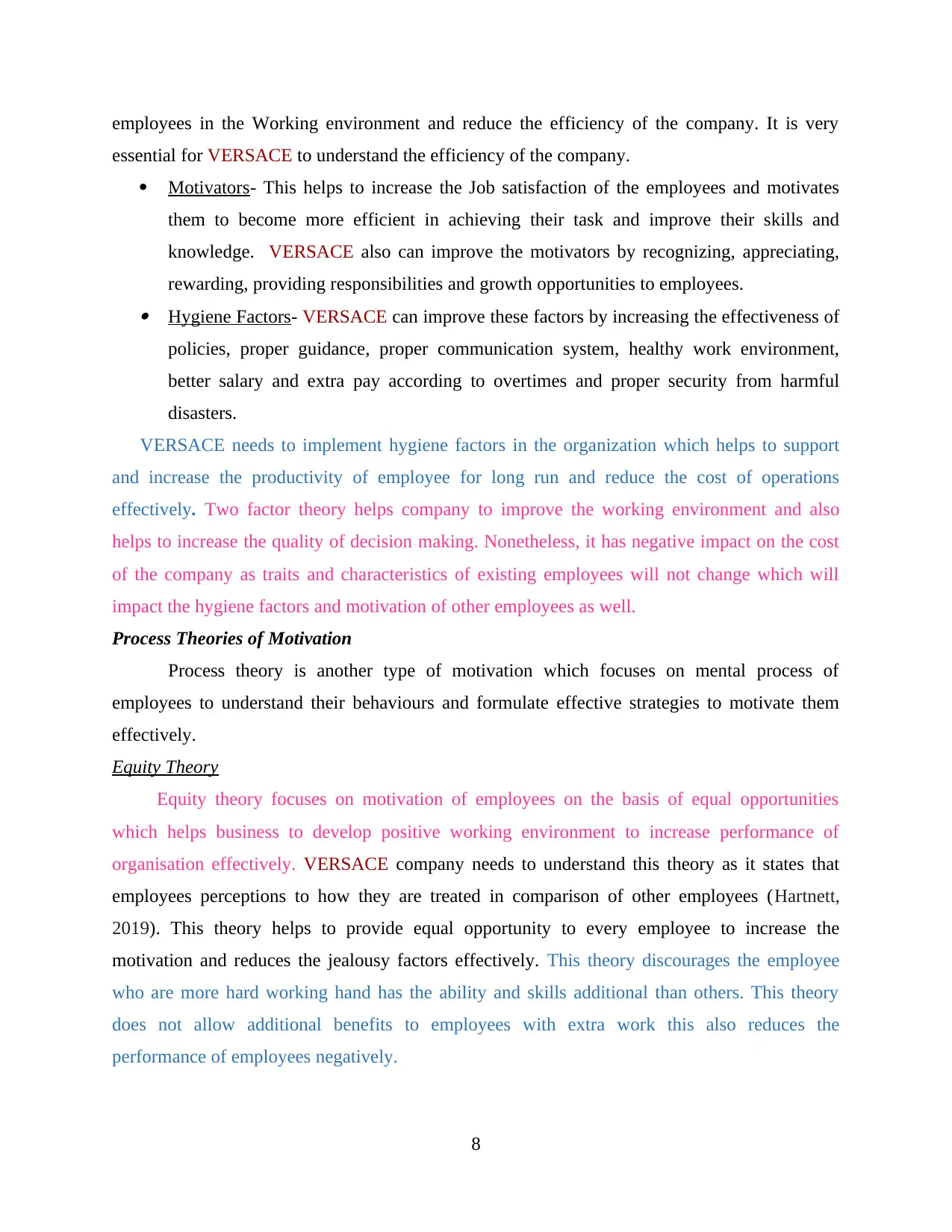
employees in the Working environment and reduce the efficiency of the company. It is very
essential for VERSACE to understand the efficiency of the company.
Motivators- This helps to increase the Job satisfaction of the employees and motivates
them to become more efficient in achieving their task and improve their skills and
knowledge. VERSACE also can improve the motivators by recognizing, appreciating,
rewarding, providing responsibilities and growth opportunities to employees. Hygiene Factors- VERSACE can improve these factors by increasing the effectiveness of
policies, proper guidance, proper communication system, healthy work environment,
better salary and extra pay according to overtimes and proper security from harmful
disasters.
VERSACE needs to implement hygiene factors in the organization which helps to support
and increase the productivity of employee for long run and reduce the cost of operations
effectively. Two factor theory helps company to improve the working environment and also
helps to increase the quality of decision making. Nonetheless, it has negative impact on the cost
of the company as traits and characteristics of existing employees will not change which will
impact the hygiene factors and motivation of other employees as well.
Process Theories of Motivation
Process theory is another type of motivation which focuses on mental process of
employees to understand their behaviours and formulate effective strategies to motivate them
effectively.
Equity Theory
Equity theory focuses on motivation of employees on the basis of equal opportunities
which helps business to develop positive working environment to increase performance of
organisation effectively. VERSACE company needs to understand this theory as it states that
employees perceptions to how they are treated in comparison of other employees (Hartnett,
2019). This theory helps to provide equal opportunity to every employee to increase the
motivation and reduces the jealousy factors effectively. This theory discourages the employee
who are more hard working hand has the ability and skills additional than others. This theory
does not allow additional benefits to employees with extra work this also reduces the
performance of employees negatively.
8
essential for VERSACE to understand the efficiency of the company.
Motivators- This helps to increase the Job satisfaction of the employees and motivates
them to become more efficient in achieving their task and improve their skills and
knowledge. VERSACE also can improve the motivators by recognizing, appreciating,
rewarding, providing responsibilities and growth opportunities to employees. Hygiene Factors- VERSACE can improve these factors by increasing the effectiveness of
policies, proper guidance, proper communication system, healthy work environment,
better salary and extra pay according to overtimes and proper security from harmful
disasters.
VERSACE needs to implement hygiene factors in the organization which helps to support
and increase the productivity of employee for long run and reduce the cost of operations
effectively. Two factor theory helps company to improve the working environment and also
helps to increase the quality of decision making. Nonetheless, it has negative impact on the cost
of the company as traits and characteristics of existing employees will not change which will
impact the hygiene factors and motivation of other employees as well.
Process Theories of Motivation
Process theory is another type of motivation which focuses on mental process of
employees to understand their behaviours and formulate effective strategies to motivate them
effectively.
Equity Theory
Equity theory focuses on motivation of employees on the basis of equal opportunities
which helps business to develop positive working environment to increase performance of
organisation effectively. VERSACE company needs to understand this theory as it states that
employees perceptions to how they are treated in comparison of other employees (Hartnett,
2019). This theory helps to provide equal opportunity to every employee to increase the
motivation and reduces the jealousy factors effectively. This theory discourages the employee
who are more hard working hand has the ability and skills additional than others. This theory
does not allow additional benefits to employees with extra work this also reduces the
performance of employees negatively.
8
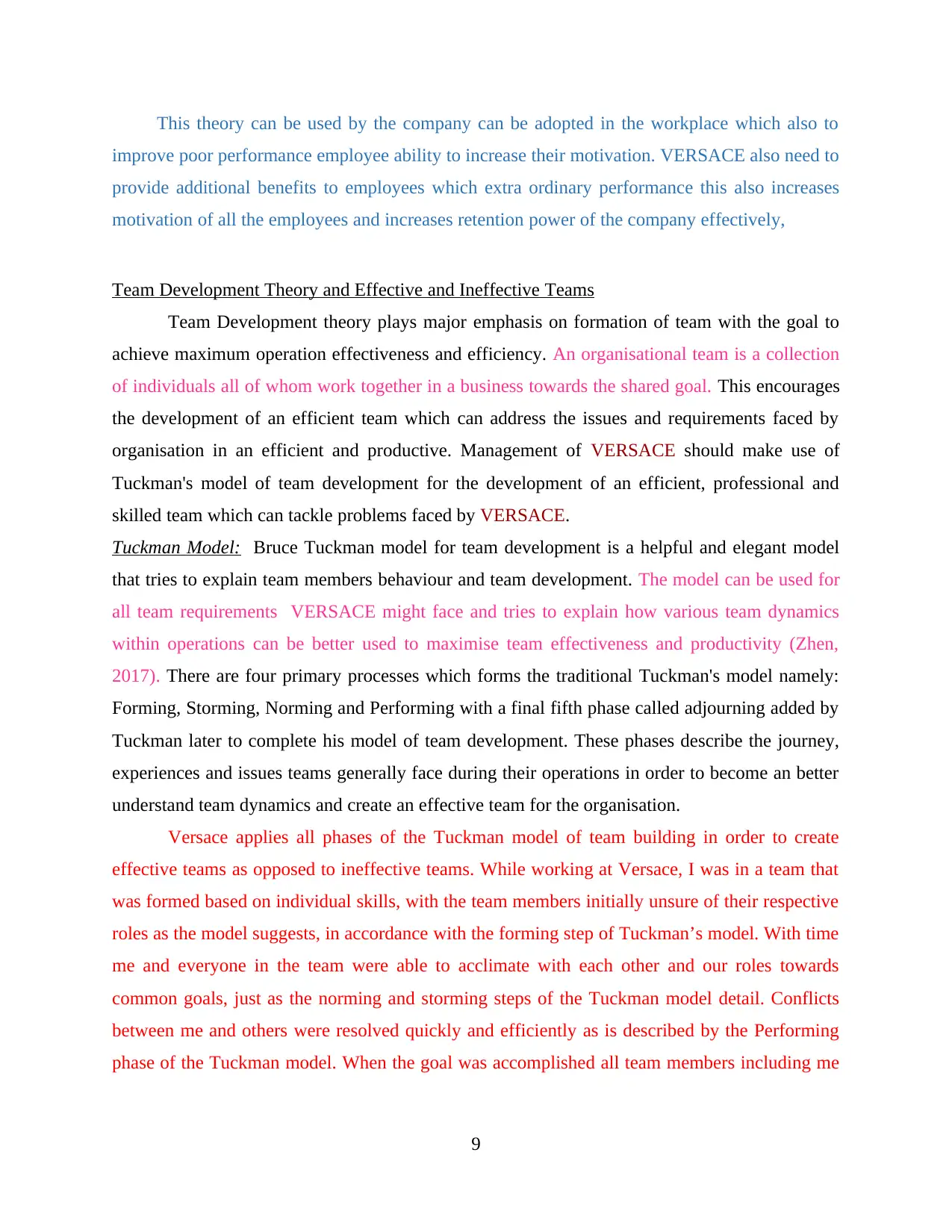
This theory can be used by the company can be adopted in the workplace which also to
improve poor performance employee ability to increase their motivation. VERSACE also need to
provide additional benefits to employees which extra ordinary performance this also increases
motivation of all the employees and increases retention power of the company effectively,
Team Development Theory and Effective and Ineffective Teams
Team Development theory plays major emphasis on formation of team with the goal to
achieve maximum operation effectiveness and efficiency. An organisational team is a collection
of individuals all of whom work together in a business towards the shared goal. This encourages
the development of an efficient team which can address the issues and requirements faced by
organisation in an efficient and productive. Management of VERSACE should make use of
Tuckman's model of team development for the development of an efficient, professional and
skilled team which can tackle problems faced by VERSACE.
Tuckman Model: Bruce Tuckman model for team development is a helpful and elegant model
that tries to explain team members behaviour and team development. The model can be used for
all team requirements VERSACE might face and tries to explain how various team dynamics
within operations can be better used to maximise team effectiveness and productivity (Zhen,
2017). There are four primary processes which forms the traditional Tuckman's model namely:
Forming, Storming, Norming and Performing with a final fifth phase called adjourning added by
Tuckman later to complete his model of team development. These phases describe the journey,
experiences and issues teams generally face during their operations in order to become an better
understand team dynamics and create an effective team for the organisation.
Versace applies all phases of the Tuckman model of team building in order to create
effective teams as opposed to ineffective teams. While working at Versace, I was in a team that
was formed based on individual skills, with the team members initially unsure of their respective
roles as the model suggests, in accordance with the forming step of Tuckman’s model. With time
me and everyone in the team were able to acclimate with each other and our roles towards
common goals, just as the norming and storming steps of the Tuckman model detail. Conflicts
between me and others were resolved quickly and efficiently as is described by the Performing
phase of the Tuckman model. When the goal was accomplished all team members including me
9
improve poor performance employee ability to increase their motivation. VERSACE also need to
provide additional benefits to employees which extra ordinary performance this also increases
motivation of all the employees and increases retention power of the company effectively,
Team Development Theory and Effective and Ineffective Teams
Team Development theory plays major emphasis on formation of team with the goal to
achieve maximum operation effectiveness and efficiency. An organisational team is a collection
of individuals all of whom work together in a business towards the shared goal. This encourages
the development of an efficient team which can address the issues and requirements faced by
organisation in an efficient and productive. Management of VERSACE should make use of
Tuckman's model of team development for the development of an efficient, professional and
skilled team which can tackle problems faced by VERSACE.
Tuckman Model: Bruce Tuckman model for team development is a helpful and elegant model
that tries to explain team members behaviour and team development. The model can be used for
all team requirements VERSACE might face and tries to explain how various team dynamics
within operations can be better used to maximise team effectiveness and productivity (Zhen,
2017). There are four primary processes which forms the traditional Tuckman's model namely:
Forming, Storming, Norming and Performing with a final fifth phase called adjourning added by
Tuckman later to complete his model of team development. These phases describe the journey,
experiences and issues teams generally face during their operations in order to become an better
understand team dynamics and create an effective team for the organisation.
Versace applies all phases of the Tuckman model of team building in order to create
effective teams as opposed to ineffective teams. While working at Versace, I was in a team that
was formed based on individual skills, with the team members initially unsure of their respective
roles as the model suggests, in accordance with the forming step of Tuckman’s model. With time
me and everyone in the team were able to acclimate with each other and our roles towards
common goals, just as the norming and storming steps of the Tuckman model detail. Conflicts
between me and others were resolved quickly and efficiently as is described by the Performing
phase of the Tuckman model. When the goal was accomplished all team members including me
9
You're viewing a preview
Unlock full access by subscribing today!
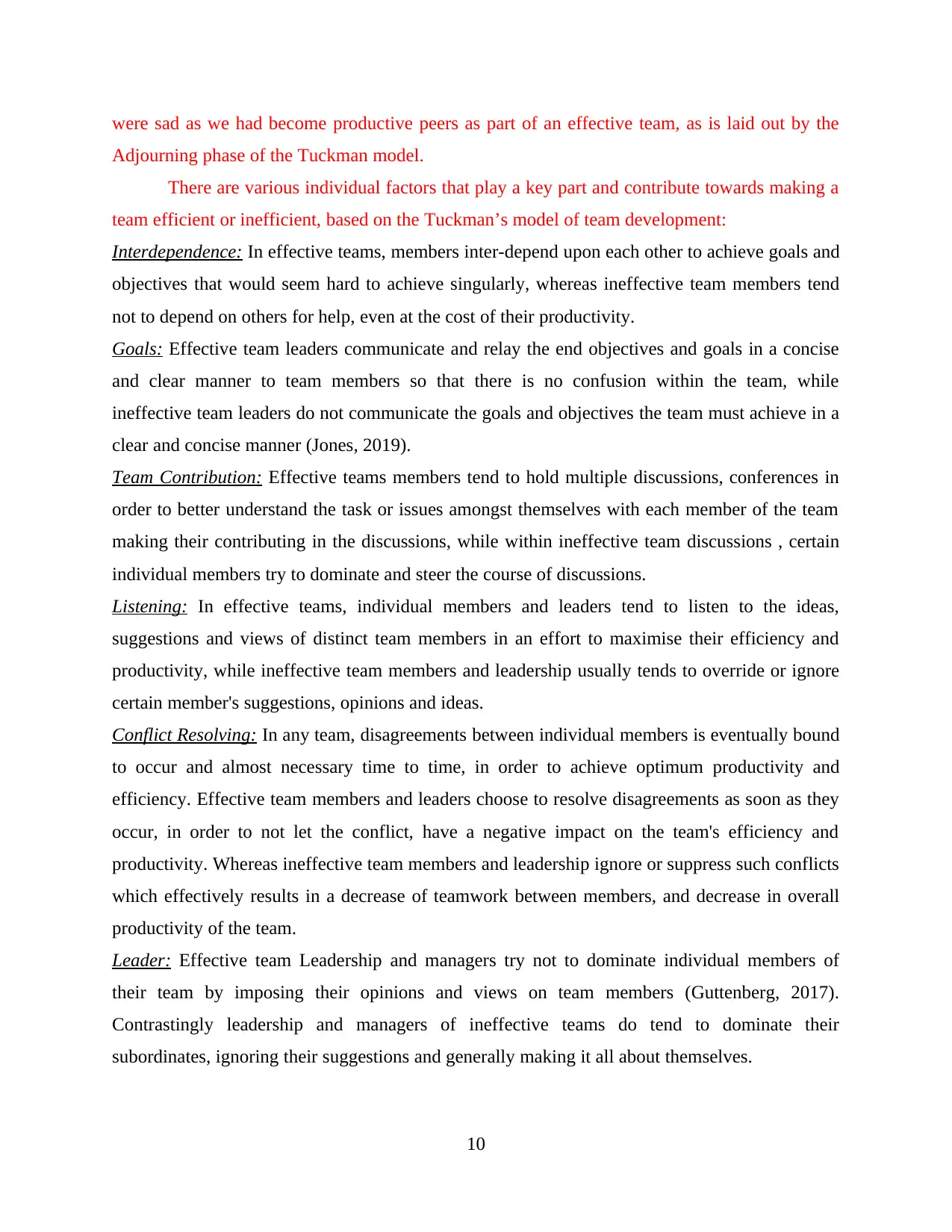
were sad as we had become productive peers as part of an effective team, as is laid out by the
Adjourning phase of the Tuckman model.
There are various individual factors that play a key part and contribute towards making a
team efficient or inefficient, based on the Tuckman’s model of team development:
Interdependence: In effective teams, members inter-depend upon each other to achieve goals and
objectives that would seem hard to achieve singularly, whereas ineffective team members tend
not to depend on others for help, even at the cost of their productivity.
Goals: Effective team leaders communicate and relay the end objectives and goals in a concise
and clear manner to team members so that there is no confusion within the team, while
ineffective team leaders do not communicate the goals and objectives the team must achieve in a
clear and concise manner (Jones, 2019).
Team Contribution: Effective teams members tend to hold multiple discussions, conferences in
order to better understand the task or issues amongst themselves with each member of the team
making their contributing in the discussions, while within ineffective team discussions , certain
individual members try to dominate and steer the course of discussions.
Listening: In effective teams, individual members and leaders tend to listen to the ideas,
suggestions and views of distinct team members in an effort to maximise their efficiency and
productivity, while ineffective team members and leadership usually tends to override or ignore
certain member's suggestions, opinions and ideas.
Conflict Resolving: In any team, disagreements between individual members is eventually bound
to occur and almost necessary time to time, in order to achieve optimum productivity and
efficiency. Effective team members and leaders choose to resolve disagreements as soon as they
occur, in order to not let the conflict, have a negative impact on the team's efficiency and
productivity. Whereas ineffective team members and leadership ignore or suppress such conflicts
which effectively results in a decrease of teamwork between members, and decrease in overall
productivity of the team.
Leader: Effective team Leadership and managers try not to dominate individual members of
their team by imposing their opinions and views on team members (Guttenberg, 2017).
Contrastingly leadership and managers of ineffective teams do tend to dominate their
subordinates, ignoring their suggestions and generally making it all about themselves.
10
Adjourning phase of the Tuckman model.
There are various individual factors that play a key part and contribute towards making a
team efficient or inefficient, based on the Tuckman’s model of team development:
Interdependence: In effective teams, members inter-depend upon each other to achieve goals and
objectives that would seem hard to achieve singularly, whereas ineffective team members tend
not to depend on others for help, even at the cost of their productivity.
Goals: Effective team leaders communicate and relay the end objectives and goals in a concise
and clear manner to team members so that there is no confusion within the team, while
ineffective team leaders do not communicate the goals and objectives the team must achieve in a
clear and concise manner (Jones, 2019).
Team Contribution: Effective teams members tend to hold multiple discussions, conferences in
order to better understand the task or issues amongst themselves with each member of the team
making their contributing in the discussions, while within ineffective team discussions , certain
individual members try to dominate and steer the course of discussions.
Listening: In effective teams, individual members and leaders tend to listen to the ideas,
suggestions and views of distinct team members in an effort to maximise their efficiency and
productivity, while ineffective team members and leadership usually tends to override or ignore
certain member's suggestions, opinions and ideas.
Conflict Resolving: In any team, disagreements between individual members is eventually bound
to occur and almost necessary time to time, in order to achieve optimum productivity and
efficiency. Effective team members and leaders choose to resolve disagreements as soon as they
occur, in order to not let the conflict, have a negative impact on the team's efficiency and
productivity. Whereas ineffective team members and leadership ignore or suppress such conflicts
which effectively results in a decrease of teamwork between members, and decrease in overall
productivity of the team.
Leader: Effective team Leadership and managers try not to dominate individual members of
their team by imposing their opinions and views on team members (Guttenberg, 2017).
Contrastingly leadership and managers of ineffective teams do tend to dominate their
subordinates, ignoring their suggestions and generally making it all about themselves.
10
Paraphrase This Document
Need a fresh take? Get an instant paraphrase of this document with our AI Paraphraser
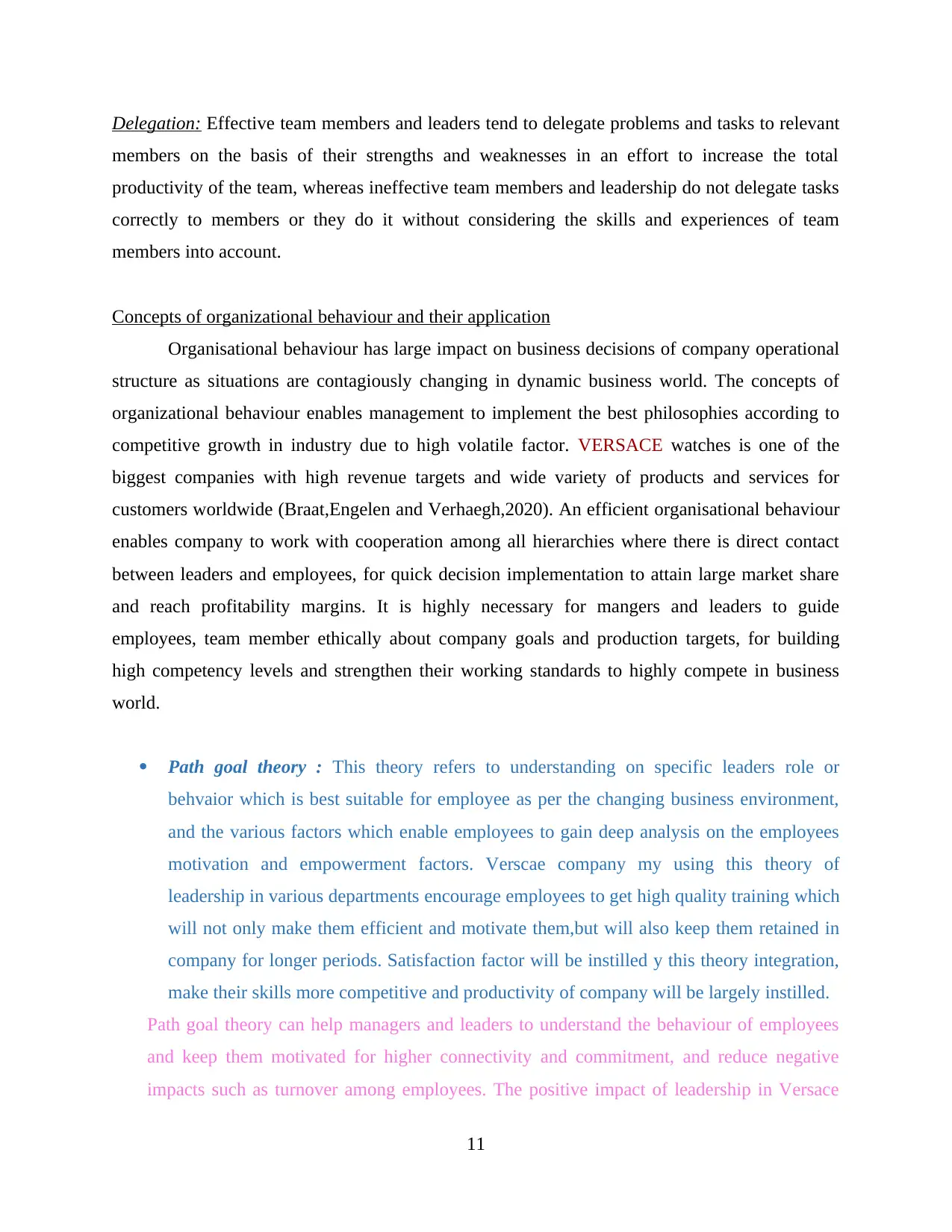
Delegation: Effective team members and leaders tend to delegate problems and tasks to relevant
members on the basis of their strengths and weaknesses in an effort to increase the total
productivity of the team, whereas ineffective team members and leadership do not delegate tasks
correctly to members or they do it without considering the skills and experiences of team
members into account.
Concepts of organizational behaviour and their application
Organisational behaviour has large impact on business decisions of company operational
structure as situations are contagiously changing in dynamic business world. The concepts of
organizational behaviour enables management to implement the best philosophies according to
competitive growth in industry due to high volatile factor. VERSACE watches is one of the
biggest companies with high revenue targets and wide variety of products and services for
customers worldwide (Braat,Engelen and Verhaegh,2020). An efficient organisational behaviour
enables company to work with cooperation among all hierarchies where there is direct contact
between leaders and employees, for quick decision implementation to attain large market share
and reach profitability margins. It is highly necessary for mangers and leaders to guide
employees, team member ethically about company goals and production targets, for building
high competency levels and strengthen their working standards to highly compete in business
world.
Path goal theory : This theory refers to understanding on specific leaders role or
behvaior which is best suitable for employee as per the changing business environment,
and the various factors which enable employees to gain deep analysis on the employees
motivation and empowerment factors. Verscae company my using this theory of
leadership in various departments encourage employees to get high quality training which
will not only make them efficient and motivate them,but will also keep them retained in
company for longer periods. Satisfaction factor will be instilled y this theory integration,
make their skills more competitive and productivity of company will be largely instilled.
Path goal theory can help managers and leaders to understand the behaviour of employees
and keep them motivated for higher connectivity and commitment, and reduce negative
impacts such as turnover among employees. The positive impact of leadership in Versace
11
members on the basis of their strengths and weaknesses in an effort to increase the total
productivity of the team, whereas ineffective team members and leadership do not delegate tasks
correctly to members or they do it without considering the skills and experiences of team
members into account.
Concepts of organizational behaviour and their application
Organisational behaviour has large impact on business decisions of company operational
structure as situations are contagiously changing in dynamic business world. The concepts of
organizational behaviour enables management to implement the best philosophies according to
competitive growth in industry due to high volatile factor. VERSACE watches is one of the
biggest companies with high revenue targets and wide variety of products and services for
customers worldwide (Braat,Engelen and Verhaegh,2020). An efficient organisational behaviour
enables company to work with cooperation among all hierarchies where there is direct contact
between leaders and employees, for quick decision implementation to attain large market share
and reach profitability margins. It is highly necessary for mangers and leaders to guide
employees, team member ethically about company goals and production targets, for building
high competency levels and strengthen their working standards to highly compete in business
world.
Path goal theory : This theory refers to understanding on specific leaders role or
behvaior which is best suitable for employee as per the changing business environment,
and the various factors which enable employees to gain deep analysis on the employees
motivation and empowerment factors. Verscae company my using this theory of
leadership in various departments encourage employees to get high quality training which
will not only make them efficient and motivate them,but will also keep them retained in
company for longer periods. Satisfaction factor will be instilled y this theory integration,
make their skills more competitive and productivity of company will be largely instilled.
Path goal theory can help managers and leaders to understand the behaviour of employees
and keep them motivated for higher connectivity and commitment, and reduce negative
impacts such as turnover among employees. The positive impact of leadership in Versace
11
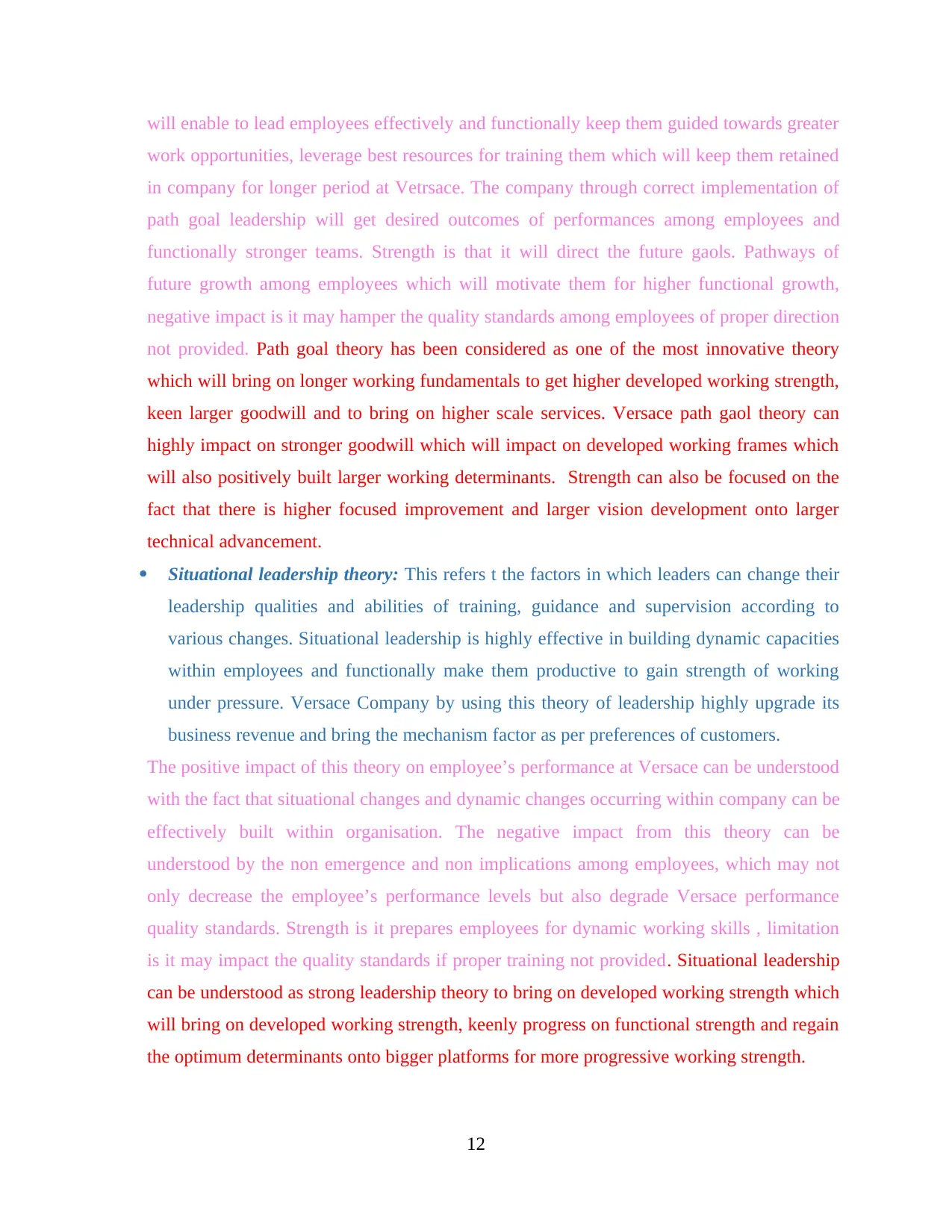
will enable to lead employees effectively and functionally keep them guided towards greater
work opportunities, leverage best resources for training them which will keep them retained
in company for longer period at Vetrsace. The company through correct implementation of
path goal leadership will get desired outcomes of performances among employees and
functionally stronger teams. Strength is that it will direct the future gaols. Pathways of
future growth among employees which will motivate them for higher functional growth,
negative impact is it may hamper the quality standards among employees of proper direction
not provided. Path goal theory has been considered as one of the most innovative theory
which will bring on longer working fundamentals to get higher developed working strength,
keen larger goodwill and to bring on higher scale services. Versace path gaol theory can
highly impact on stronger goodwill which will impact on developed working frames which
will also positively built larger working determinants. Strength can also be focused on the
fact that there is higher focused improvement and larger vision development onto larger
technical advancement.
Situational leadership theory: This refers t the factors in which leaders can change their
leadership qualities and abilities of training, guidance and supervision according to
various changes. Situational leadership is highly effective in building dynamic capacities
within employees and functionally make them productive to gain strength of working
under pressure. Versace Company by using this theory of leadership highly upgrade its
business revenue and bring the mechanism factor as per preferences of customers.
The positive impact of this theory on employee’s performance at Versace can be understood
with the fact that situational changes and dynamic changes occurring within company can be
effectively built within organisation. The negative impact from this theory can be
understood by the non emergence and non implications among employees, which may not
only decrease the employee’s performance levels but also degrade Versace performance
quality standards. Strength is it prepares employees for dynamic working skills , limitation
is it may impact the quality standards if proper training not provided. Situational leadership
can be understood as strong leadership theory to bring on developed working strength which
will bring on developed working strength, keenly progress on functional strength and regain
the optimum determinants onto bigger platforms for more progressive working strength.
12
work opportunities, leverage best resources for training them which will keep them retained
in company for longer period at Vetrsace. The company through correct implementation of
path goal leadership will get desired outcomes of performances among employees and
functionally stronger teams. Strength is that it will direct the future gaols. Pathways of
future growth among employees which will motivate them for higher functional growth,
negative impact is it may hamper the quality standards among employees of proper direction
not provided. Path goal theory has been considered as one of the most innovative theory
which will bring on longer working fundamentals to get higher developed working strength,
keen larger goodwill and to bring on higher scale services. Versace path gaol theory can
highly impact on stronger goodwill which will impact on developed working frames which
will also positively built larger working determinants. Strength can also be focused on the
fact that there is higher focused improvement and larger vision development onto larger
technical advancement.
Situational leadership theory: This refers t the factors in which leaders can change their
leadership qualities and abilities of training, guidance and supervision according to
various changes. Situational leadership is highly effective in building dynamic capacities
within employees and functionally make them productive to gain strength of working
under pressure. Versace Company by using this theory of leadership highly upgrade its
business revenue and bring the mechanism factor as per preferences of customers.
The positive impact of this theory on employee’s performance at Versace can be understood
with the fact that situational changes and dynamic changes occurring within company can be
effectively built within organisation. The negative impact from this theory can be
understood by the non emergence and non implications among employees, which may not
only decrease the employee’s performance levels but also degrade Versace performance
quality standards. Strength is it prepares employees for dynamic working skills , limitation
is it may impact the quality standards if proper training not provided. Situational leadership
can be understood as strong leadership theory to bring on developed working strength which
will bring on developed working strength, keenly progress on functional strength and regain
the optimum determinants onto bigger platforms for more progressive working strength.
12
You're viewing a preview
Unlock full access by subscribing today!
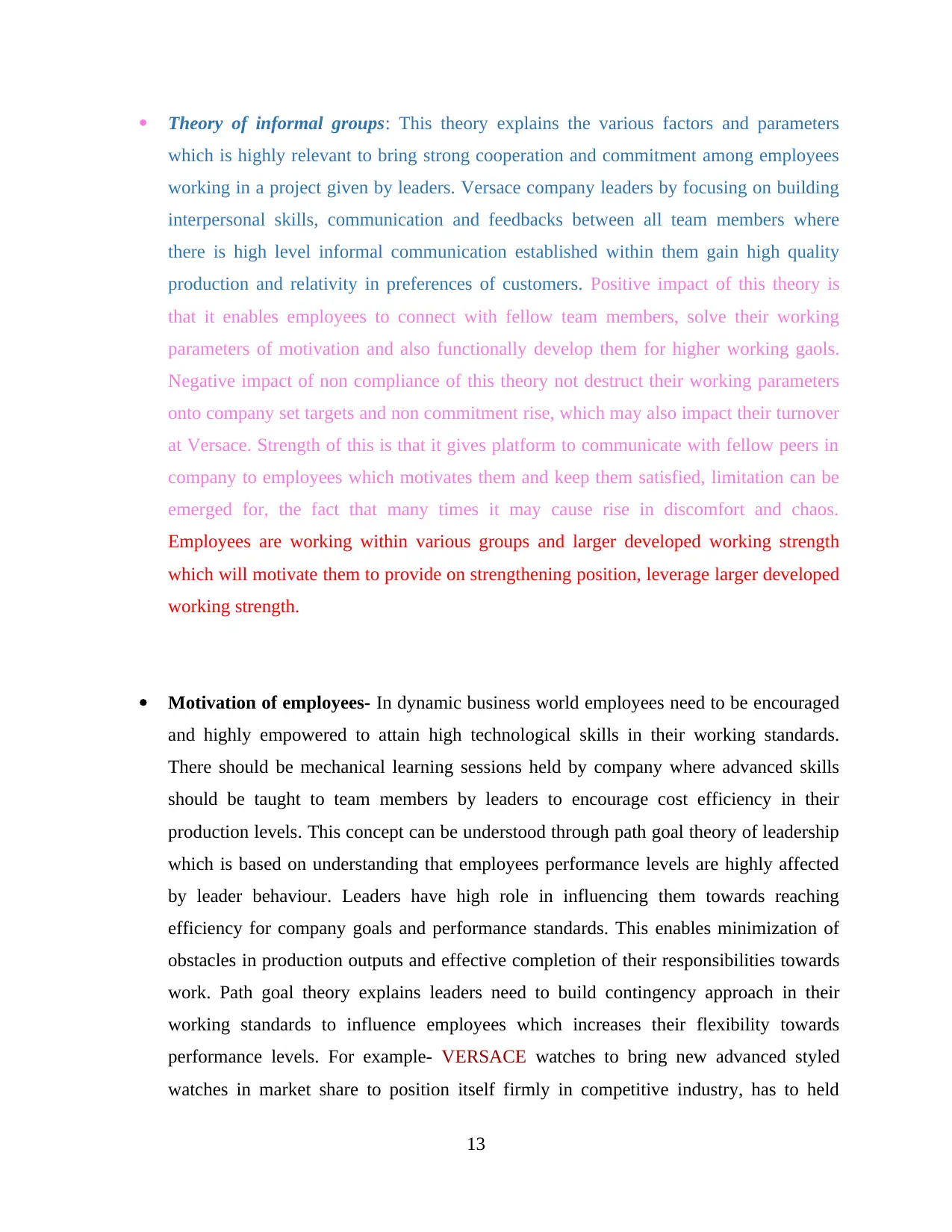
Theory of informal groups: This theory explains the various factors and parameters
which is highly relevant to bring strong cooperation and commitment among employees
working in a project given by leaders. Versace company leaders by focusing on building
interpersonal skills, communication and feedbacks between all team members where
there is high level informal communication established within them gain high quality
production and relativity in preferences of customers. Positive impact of this theory is
that it enables employees to connect with fellow team members, solve their working
parameters of motivation and also functionally develop them for higher working gaols.
Negative impact of non compliance of this theory not destruct their working parameters
onto company set targets and non commitment rise, which may also impact their turnover
at Versace. Strength of this is that it gives platform to communicate with fellow peers in
company to employees which motivates them and keep them satisfied, limitation can be
emerged for, the fact that many times it may cause rise in discomfort and chaos.
Employees are working within various groups and larger developed working strength
which will motivate them to provide on strengthening position, leverage larger developed
working strength.
Motivation of employees- In dynamic business world employees need to be encouraged
and highly empowered to attain high technological skills in their working standards.
There should be mechanical learning sessions held by company where advanced skills
should be taught to team members by leaders to encourage cost efficiency in their
production levels. This concept can be understood through path goal theory of leadership
which is based on understanding that employees performance levels are highly affected
by leader behaviour. Leaders have high role in influencing them towards reaching
efficiency for company goals and performance standards. This enables minimization of
obstacles in production outputs and effective completion of their responsibilities towards
work. Path goal theory explains leaders need to build contingency approach in their
working standards to influence employees which increases their flexibility towards
performance levels. For example- VERSACE watches to bring new advanced styled
watches in market share to position itself firmly in competitive industry, has to held
13
which is highly relevant to bring strong cooperation and commitment among employees
working in a project given by leaders. Versace company leaders by focusing on building
interpersonal skills, communication and feedbacks between all team members where
there is high level informal communication established within them gain high quality
production and relativity in preferences of customers. Positive impact of this theory is
that it enables employees to connect with fellow team members, solve their working
parameters of motivation and also functionally develop them for higher working gaols.
Negative impact of non compliance of this theory not destruct their working parameters
onto company set targets and non commitment rise, which may also impact their turnover
at Versace. Strength of this is that it gives platform to communicate with fellow peers in
company to employees which motivates them and keep them satisfied, limitation can be
emerged for, the fact that many times it may cause rise in discomfort and chaos.
Employees are working within various groups and larger developed working strength
which will motivate them to provide on strengthening position, leverage larger developed
working strength.
Motivation of employees- In dynamic business world employees need to be encouraged
and highly empowered to attain high technological skills in their working standards.
There should be mechanical learning sessions held by company where advanced skills
should be taught to team members by leaders to encourage cost efficiency in their
production levels. This concept can be understood through path goal theory of leadership
which is based on understanding that employees performance levels are highly affected
by leader behaviour. Leaders have high role in influencing them towards reaching
efficiency for company goals and performance standards. This enables minimization of
obstacles in production outputs and effective completion of their responsibilities towards
work. Path goal theory explains leaders need to build contingency approach in their
working standards to influence employees which increases their flexibility towards
performance levels. For example- VERSACE watches to bring new advanced styled
watches in market share to position itself firmly in competitive industry, has to held
13
Paraphrase This Document
Need a fresh take? Get an instant paraphrase of this document with our AI Paraphraser
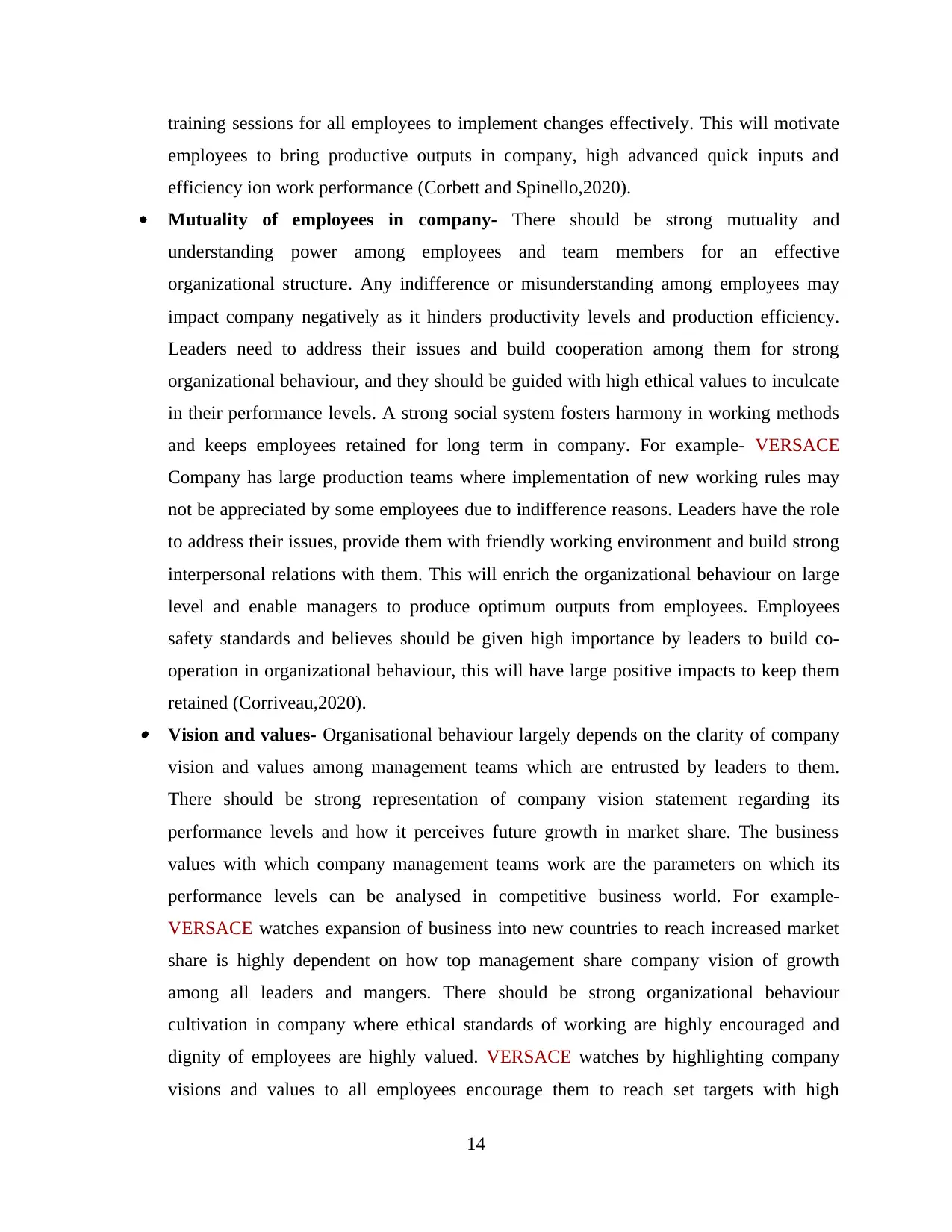
training sessions for all employees to implement changes effectively. This will motivate
employees to bring productive outputs in company, high advanced quick inputs and
efficiency ion work performance (Corbett and Spinello,2020).
Mutuality of employees in company- There should be strong mutuality and
understanding power among employees and team members for an effective
organizational structure. Any indifference or misunderstanding among employees may
impact company negatively as it hinders productivity levels and production efficiency.
Leaders need to address their issues and build cooperation among them for strong
organizational behaviour, and they should be guided with high ethical values to inculcate
in their performance levels. A strong social system fosters harmony in working methods
and keeps employees retained for long term in company. For example- VERSACE
Company has large production teams where implementation of new working rules may
not be appreciated by some employees due to indifference reasons. Leaders have the role
to address their issues, provide them with friendly working environment and build strong
interpersonal relations with them. This will enrich the organizational behaviour on large
level and enable managers to produce optimum outputs from employees. Employees
safety standards and believes should be given high importance by leaders to build co-
operation in organizational behaviour, this will have large positive impacts to keep them
retained (Corriveau,2020). Vision and values- Organisational behaviour largely depends on the clarity of company
vision and values among management teams which are entrusted by leaders to them.
There should be strong representation of company vision statement regarding its
performance levels and how it perceives future growth in market share. The business
values with which company management teams work are the parameters on which its
performance levels can be analysed in competitive business world. For example-
VERSACE watches expansion of business into new countries to reach increased market
share is highly dependent on how top management share company vision of growth
among all leaders and mangers. There should be strong organizational behaviour
cultivation in company where ethical standards of working are highly encouraged and
dignity of employees are highly valued. VERSACE watches by highlighting company
visions and values to all employees encourage them to reach set targets with high
14
employees to bring productive outputs in company, high advanced quick inputs and
efficiency ion work performance (Corbett and Spinello,2020).
Mutuality of employees in company- There should be strong mutuality and
understanding power among employees and team members for an effective
organizational structure. Any indifference or misunderstanding among employees may
impact company negatively as it hinders productivity levels and production efficiency.
Leaders need to address their issues and build cooperation among them for strong
organizational behaviour, and they should be guided with high ethical values to inculcate
in their performance levels. A strong social system fosters harmony in working methods
and keeps employees retained for long term in company. For example- VERSACE
Company has large production teams where implementation of new working rules may
not be appreciated by some employees due to indifference reasons. Leaders have the role
to address their issues, provide them with friendly working environment and build strong
interpersonal relations with them. This will enrich the organizational behaviour on large
level and enable managers to produce optimum outputs from employees. Employees
safety standards and believes should be given high importance by leaders to build co-
operation in organizational behaviour, this will have large positive impacts to keep them
retained (Corriveau,2020). Vision and values- Organisational behaviour largely depends on the clarity of company
vision and values among management teams which are entrusted by leaders to them.
There should be strong representation of company vision statement regarding its
performance levels and how it perceives future growth in market share. The business
values with which company management teams work are the parameters on which its
performance levels can be analysed in competitive business world. For example-
VERSACE watches expansion of business into new countries to reach increased market
share is highly dependent on how top management share company vision of growth
among all leaders and mangers. There should be strong organizational behaviour
cultivation in company where ethical standards of working are highly encouraged and
dignity of employees are highly valued. VERSACE watches by highlighting company
visions and values to all employees encourage them to reach set targets with high
14
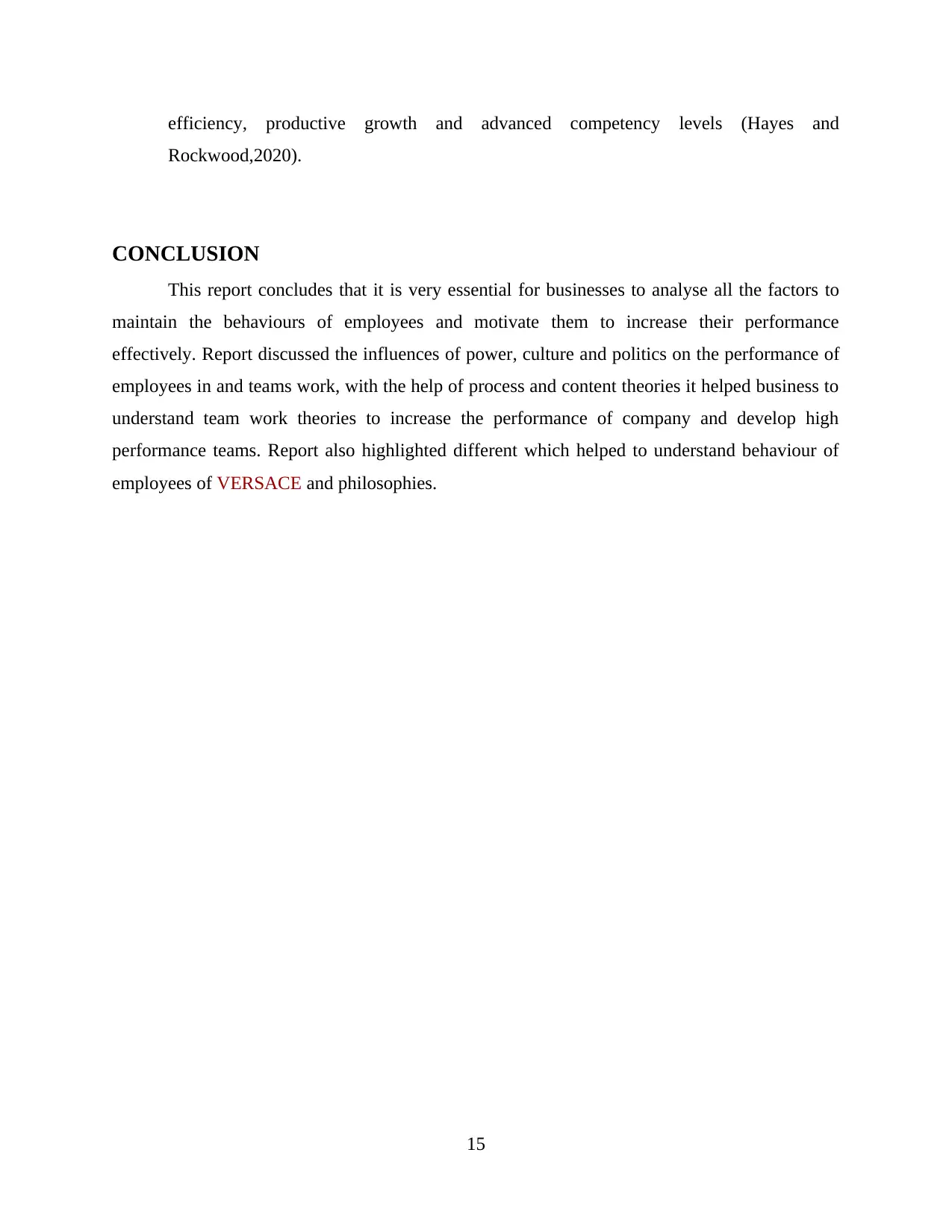
efficiency, productive growth and advanced competency levels (Hayes and
Rockwood,2020).
CONCLUSION
This report concludes that it is very essential for businesses to analyse all the factors to
maintain the behaviours of employees and motivate them to increase their performance
effectively. Report discussed the influences of power, culture and politics on the performance of
employees in and teams work, with the help of process and content theories it helped business to
understand team work theories to increase the performance of company and develop high
performance teams. Report also highlighted different which helped to understand behaviour of
employees of VERSACE and philosophies.
15
Rockwood,2020).
CONCLUSION
This report concludes that it is very essential for businesses to analyse all the factors to
maintain the behaviours of employees and motivate them to increase their performance
effectively. Report discussed the influences of power, culture and politics on the performance of
employees in and teams work, with the help of process and content theories it helped business to
understand team work theories to increase the performance of company and develop high
performance teams. Report also highlighted different which helped to understand behaviour of
employees of VERSACE and philosophies.
15
You're viewing a preview
Unlock full access by subscribing today!
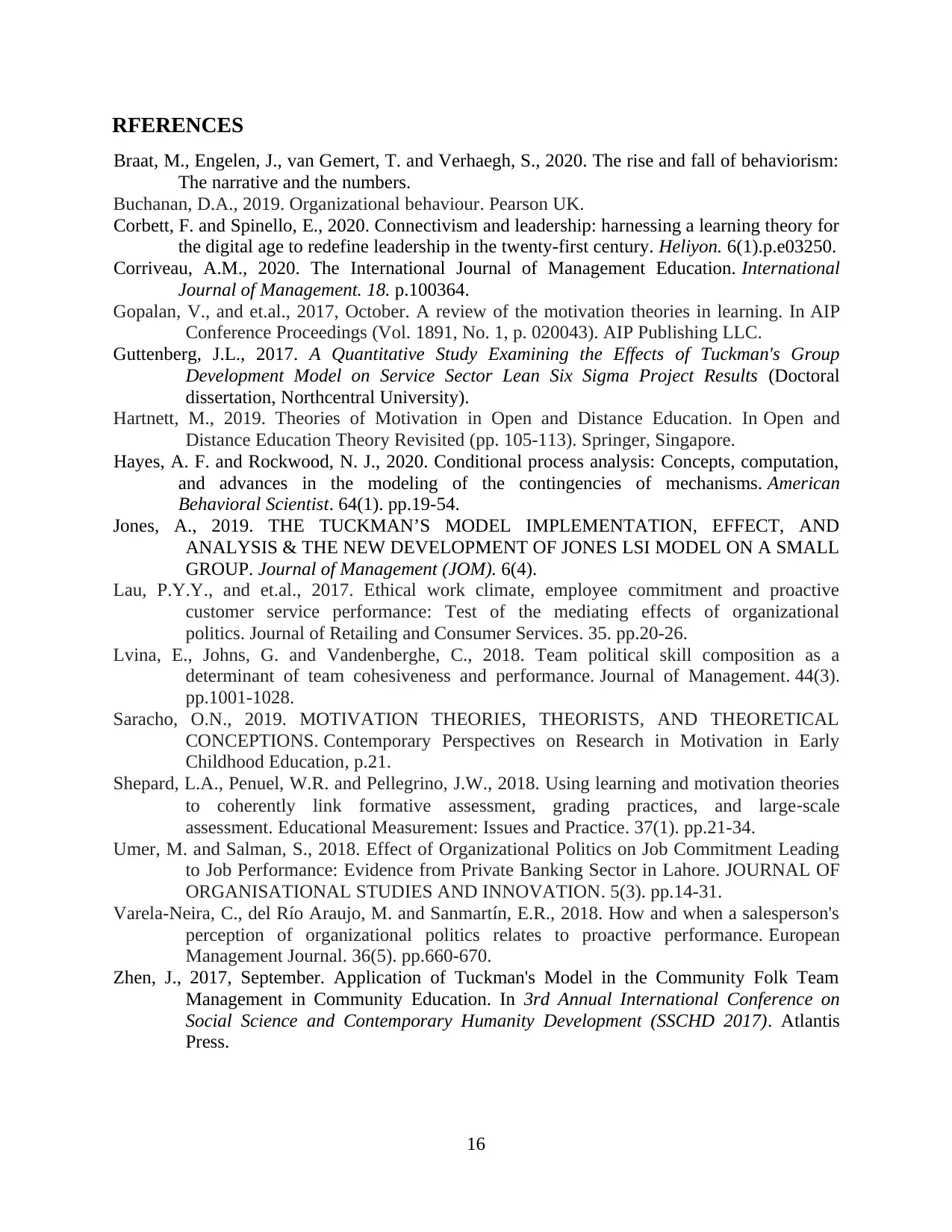
RFERENCES
Braat, M., Engelen, J., van Gemert, T. and Verhaegh, S., 2020. The rise and fall of behaviorism:
The narrative and the numbers.
Buchanan, D.A., 2019. Organizational behaviour. Pearson UK.
Corbett, F. and Spinello, E., 2020. Connectivism and leadership: harnessing a learning theory for
the digital age to redefine leadership in the twenty-first century. Heliyon. 6(1).p.e03250.
Corriveau, A.M., 2020. The International Journal of Management Education. International
Journal of Management. 18. p.100364.
Gopalan, V., and et.al., 2017, October. A review of the motivation theories in learning. In AIP
Conference Proceedings (Vol. 1891, No. 1, p. 020043). AIP Publishing LLC.
Guttenberg, J.L., 2017. A Quantitative Study Examining the Effects of Tuckman's Group
Development Model on Service Sector Lean Six Sigma Project Results (Doctoral
dissertation, Northcentral University).
Hartnett, M., 2019. Theories of Motivation in Open and Distance Education. In Open and
Distance Education Theory Revisited (pp. 105-113). Springer, Singapore.
Hayes, A. F. and Rockwood, N. J., 2020. Conditional process analysis: Concepts, computation,
and advances in the modeling of the contingencies of mechanisms. American
Behavioral Scientist. 64(1). pp.19-54.
Jones, A., 2019. THE TUCKMAN’S MODEL IMPLEMENTATION, EFFECT, AND
ANALYSIS & THE NEW DEVELOPMENT OF JONES LSI MODEL ON A SMALL
GROUP. Journal of Management (JOM). 6(4).
Lau, P.Y.Y., and et.al., 2017. Ethical work climate, employee commitment and proactive
customer service performance: Test of the mediating effects of organizational
politics. Journal of Retailing and Consumer Services. 35. pp.20-26.
Lvina, E., Johns, G. and Vandenberghe, C., 2018. Team political skill composition as a
determinant of team cohesiveness and performance. Journal of Management. 44(3).
pp.1001-1028.
Saracho, O.N., 2019. MOTIVATION THEORIES, THEORISTS, AND THEORETICAL
CONCEPTIONS. Contemporary Perspectives on Research in Motivation in Early
Childhood Education, p.21.
Shepard, L.A., Penuel, W.R. and Pellegrino, J.W., 2018. Using learning and motivation theories
to coherently link formative assessment, grading practices, and large‐scale
assessment. Educational Measurement: Issues and Practice. 37(1). pp.21-34.
Umer, M. and Salman, S., 2018. Effect of Organizational Politics on Job Commitment Leading
to Job Performance: Evidence from Private Banking Sector in Lahore. JOURNAL OF
ORGANISATIONAL STUDIES AND INNOVATION. 5(3). pp.14-31.
Varela-Neira, C., del Río Araujo, M. and Sanmartín, E.R., 2018. How and when a salesperson's
perception of organizational politics relates to proactive performance. European
Management Journal. 36(5). pp.660-670.
Zhen, J., 2017, September. Application of Tuckman's Model in the Community Folk Team
Management in Community Education. In 3rd Annual International Conference on
Social Science and Contemporary Humanity Development (SSCHD 2017). Atlantis
Press.
16
Braat, M., Engelen, J., van Gemert, T. and Verhaegh, S., 2020. The rise and fall of behaviorism:
The narrative and the numbers.
Buchanan, D.A., 2019. Organizational behaviour. Pearson UK.
Corbett, F. and Spinello, E., 2020. Connectivism and leadership: harnessing a learning theory for
the digital age to redefine leadership in the twenty-first century. Heliyon. 6(1).p.e03250.
Corriveau, A.M., 2020. The International Journal of Management Education. International
Journal of Management. 18. p.100364.
Gopalan, V., and et.al., 2017, October. A review of the motivation theories in learning. In AIP
Conference Proceedings (Vol. 1891, No. 1, p. 020043). AIP Publishing LLC.
Guttenberg, J.L., 2017. A Quantitative Study Examining the Effects of Tuckman's Group
Development Model on Service Sector Lean Six Sigma Project Results (Doctoral
dissertation, Northcentral University).
Hartnett, M., 2019. Theories of Motivation in Open and Distance Education. In Open and
Distance Education Theory Revisited (pp. 105-113). Springer, Singapore.
Hayes, A. F. and Rockwood, N. J., 2020. Conditional process analysis: Concepts, computation,
and advances in the modeling of the contingencies of mechanisms. American
Behavioral Scientist. 64(1). pp.19-54.
Jones, A., 2019. THE TUCKMAN’S MODEL IMPLEMENTATION, EFFECT, AND
ANALYSIS & THE NEW DEVELOPMENT OF JONES LSI MODEL ON A SMALL
GROUP. Journal of Management (JOM). 6(4).
Lau, P.Y.Y., and et.al., 2017. Ethical work climate, employee commitment and proactive
customer service performance: Test of the mediating effects of organizational
politics. Journal of Retailing and Consumer Services. 35. pp.20-26.
Lvina, E., Johns, G. and Vandenberghe, C., 2018. Team political skill composition as a
determinant of team cohesiveness and performance. Journal of Management. 44(3).
pp.1001-1028.
Saracho, O.N., 2019. MOTIVATION THEORIES, THEORISTS, AND THEORETICAL
CONCEPTIONS. Contemporary Perspectives on Research in Motivation in Early
Childhood Education, p.21.
Shepard, L.A., Penuel, W.R. and Pellegrino, J.W., 2018. Using learning and motivation theories
to coherently link formative assessment, grading practices, and large‐scale
assessment. Educational Measurement: Issues and Practice. 37(1). pp.21-34.
Umer, M. and Salman, S., 2018. Effect of Organizational Politics on Job Commitment Leading
to Job Performance: Evidence from Private Banking Sector in Lahore. JOURNAL OF
ORGANISATIONAL STUDIES AND INNOVATION. 5(3). pp.14-31.
Varela-Neira, C., del Río Araujo, M. and Sanmartín, E.R., 2018. How and when a salesperson's
perception of organizational politics relates to proactive performance. European
Management Journal. 36(5). pp.660-670.
Zhen, J., 2017, September. Application of Tuckman's Model in the Community Folk Team
Management in Community Education. In 3rd Annual International Conference on
Social Science and Contemporary Humanity Development (SSCHD 2017). Atlantis
Press.
16
1 out of 16
Related Documents
Your All-in-One AI-Powered Toolkit for Academic Success.
+13062052269
info@desklib.com
Available 24*7 on WhatsApp / Email
![[object Object]](/_next/static/media/star-bottom.7253800d.svg)
Unlock your academic potential
© 2024 | Zucol Services PVT LTD | All rights reserved.





